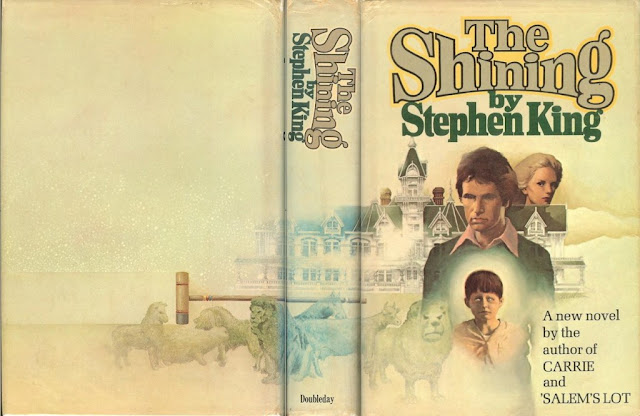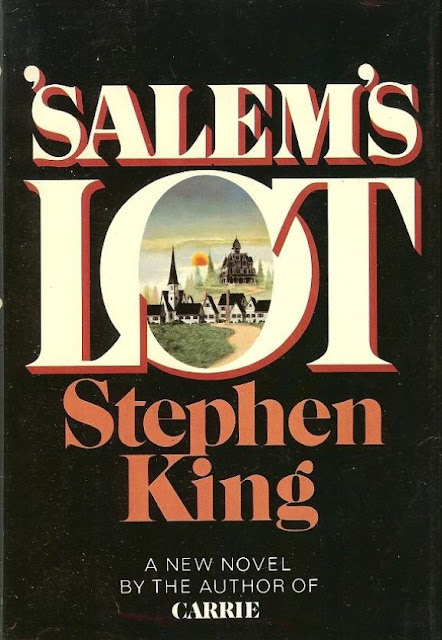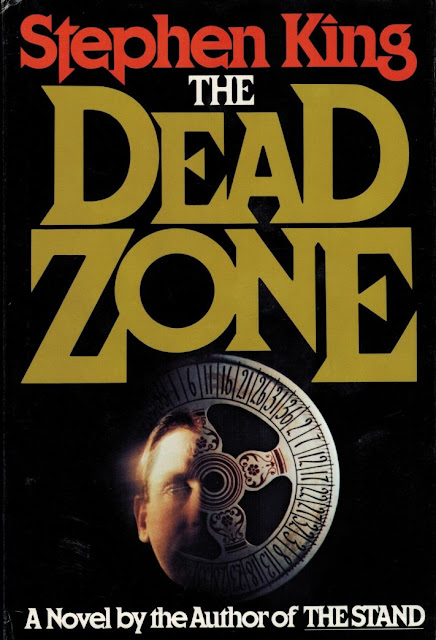* * * *
Bhob Stewart: We broke off last issue with a mention of New American Library designer Jim Plumeri's visual concept for King's Night Shift collection: a clever double cover with six eyes peering through die-cut eye slits in the dark blue background. Opening this front cover to page one you discover that the eyes are actually socketed into the palm, thumb and fingers of a half-bandaged hand, a Don Brautigam illustration of King's story I Am the Doorway about an astronaut back from Venus who finds that aliens inside him are metamorphosing his body. Brautigam's skilled use of surrealism techniques earned him a Society of Illustrators award for this airbrush/acrylic painting. Equally effective are Plumeri's other award-winning covers for King titles. "I call them occult solutions" says Plumeri. "When I did Stephen King I was looking for the most unusual solutions I could possibly find. My job is to make people stop and pick the book up. I can't drag them to the cash register. but I can sure as hell make them pick it up."
For the first million copies of the paperback edition of The Shining, Plumeri devised a small, faceless head and had it printed in black on a glistening silver mylar. "I don't have to have that kind of visual now. I can just put "Stephen King". By the time The Shining comes out by Kubrick, with Jack Nicholson in it, I think all I have to do is put a big STEPHEN KING on the cover. The Shining is Kubrick's baby; whatever he has for his advertising visual I will do. In all movie tie-ins the movie usually supplies us with their advertising art and typography. It's a chance where they get extra exposure and we get exposure. One hand washes the other."
Plumeri's occult solution for the initial paperback printing of Salem's Lot won an award from the American Institute of Graphic Arts. This was a cover of lustrous solid black - no title, no blurbs, no byline - with a single, tiny drop of red blood at the mouth of an embossed head hardly visible unless held and angled so that the embossing can catch the light. Plumeri chose type designer Pete Gute to handle the illustration because Gute had previously worked with embossed type. A follow up version of this cover added a silver embossed title above the embossed head. In its final form (the one currently in bookstores), the embossed cover was replaced by a photograph of the same head with regular flat printing. "That happened because we ran out of the special black stock." Plumeri explained. "I had photographed the original head see how it would work with dramatic lighting on the raised surface. When we ran into this emergency. I pulled this photograph out and decided that it could be used for art."
The paperback jacket for The Stand has a frightening beauty that goes beyond the merely hypnotic to become a trance-inducing glissade into ethereal evil. It combines a Richard Rossiter type design with a Brautigam airbrush painting based on a Plumeri concept sketch. "I use paint or pastel - whatever is available to give me the effect that I'm trying to portray to the artist" said Plumeri. "The sketches are rough. but they can see the concept without any problem. Don and I work well together. Throughout The Stand the evil character is described with these burning eyes, almost red, and the there is a symbolism of a crow that pops into the book at different parts. Someone sees the red, glaring eyes. and for a second thinks he sees this evil character. At that point I thought of this double image using the black crow and the evil and letting one eye work for both to give it this supernatural quality. "
Where Jim Plumeri's conceptual transpositions of King's writing into innovative paperback covers have been appropriate, relevant and ambiguously intriguing, the Doubleday hardbacks with a yawning indifference to King's fresh slant on contemporary horror fiction, have featured only mundane designs and illustrations so trapped in tradition that they lack any genuine imaginative thrust. Stephen King's own reactions to the art that wraps his words kicks off Part 2 of this serialized interview:
Bhob: The jacket on the hardback Carrie has nothing to do with the book.
Stephen King: Yes, well. it doesn't. My editor and I had a concept on that, but of course, one of the things about Bill Thompson, my editor, was that he was a man with relatively little power at Doubleday and it kept showing up in funny little ways. When I left Doubleday, they canned him. It was kind of like a tantrum: "We'll kill the messenger that brought the bad news." Our concept of the jacket would have been a Grandma Moses-type primitive painting of a New England village that would have gone around in a wrap to the back. But the jacket was done by Alex Gotfryd, who does have a lot of power at Doubleday. What he gave us was a photograph of a New York model who looks like a New York model. She doesn't even look like a teenager.
Bhob: How do you feel about the montage on The Shining hardback?
King: Don't care for that either. It makes the people look too specific. It's almost a Gothic romance jacket. There are some nice things about that jacket - I object to the faces of Jack, Wendy, and the little boy, but I like the concept of having the hedge animals. The hardback Night Shift has a classy jacket of just words, but it looks like a Doubleday-type jacket for a book they didn't expect to sell. There's nothing really exciting about that graphic.
Bhob: The long-distance view of the town on the Salem's Lot hardback doesn't indicate the book's true nature.
King: I think that was intentional. The flap copy on Salem's Lot is a real collaboration: my editor wrote part of it, his secretary wrote part of it, I wrote part of it, and my wife wrote part of it. It was just an effort to say something without saying anything. Of all the Doubleday jackets, I think that I like The Stand the best, but Salem's Lot runs that a close second. I like the idea of the black background with the town inset in the "O" of Lot. You can look into the town, and you see the Marsten house. That's a pretty decent jacket. That was the best produced book by Doubleday: all the way around, that was a good piece of work.
The illustration for the hardback of The Stand was taken from a Goya painting, The Battle Of Good and Evil - it was repainted. I was mad that they didn't give poor old Goya a credit.1 There are a lot of people who are rather literal-minded, kind of nerdy about book jackets, who don't like it because they say that it doesn't look like what the book is about. But it looks like what the spirit of the book is about. New American Library's The Stand cover is super. I think that it's a good one: I like the dark blues and turquoises in it. The paperback covers have always been better because paperback people seem to understand how to market books, how to go about that. Illustrators and designers don't get credit on paperback jackets the way they do on hardcovers.
Bhob: Then there's The Shining in mylar...
King: Except that it was discontinued, as was the dead black cover on Salem's Lot. Both of those were expensive covers. The Salem's Lot cover cost seven cents right off the top of a book that originally sold for $1.95. The mylar was nine cents, and in addition, the mylar cover buffs. It doesn't peel, but the lettering and picture gradually buff off the book. Now they just have a plain paper cover with the same picture: it's not as eye-catching, but it lasts longer.
Bhob: Did it occur to you that the wearing away of fragments of The Shining's cover produces a strange, corrosive effect that some readers might consider an additional horrific bonus?
King: I hadn't thought of it that way - maybe it is. There are people who treasure those copies: some
day maybe those will be worth some money, especially the ones that are in good condition, because on the ones that have been read. the cover wears off very quickly. The mylar was really discontinued not just because it buffed in people's hands, but because it buffed in the boxes when they were shipped. I also like the paperback Night Shift cover: it's a deep. dark. rich blue. Some of the editions are perfect, and on some, the holes are not over the eyes. Again, that was a difficult one to do: there is such a thing as being too clever by half.
Bhob: What was on the Carrie paperback before the movie tie in?
King: That cover has gone totally out of print. The original paperback had no title, no author, no printed material of any kind on the front cover. It simply showed a girl's head floating against this blue backdrop — a pretty girl with very dark hair swept back. It was a painting. a rather nice one(by James Barkley). Inside, there was a second jacket. Originally. it was to have been die-cut down the side in a two-step effect: the title, Carrie, reading vertically down the right-hand margin, was supposed to show and, at the last minute their printer told them that he couldn't do it. Inside there's this town going up in flames, and that is an interesting effect. You reach the end of the book, and there's a photograph on what they call the third cover of the same town crumpled up into nothing but ash. I don't know if that's ever been done before: having another picture inside the back jacket. These were photographs (by Allen Vogel) of flames and a model town that looks as though it was one of these origami things created out of cardboard.
Bhob: The One + One Studio's design for The Dead Zone (Viking) illustrates the repetitive wheel-of-fortune device used throughout the novel.
King: I like that jacket pretty well. I think that, in a large measure, it's been responsible for some of the book's success because it's a very high contrast type, something I think Viking might have lifted from the paperback houses. It comes out at the reader there's so much black. The thing I don't like is the photographic effect: I've never cared for photographed jackets. I can't really even say why, but they seem too realistic to me. I would have liked that jacket better if it had been that same cover design - only painted. By the time you get up to six books, you have mixed feelings. Salem's Lot was the best produced of the Doubleday books. Night Shift would be second, and probably The Shining, third. The Dead Zone is the best produced of all the works. But it's more than just cover. The cover is something that, you hope, entices readers who don't know your work to look. But it probably doesn't mean that much to people who have read you before. If they really turn on to what you're doing, they look for the name, and they'll buy the book on the basis of that. Like this new Led Zeppelin album packaged in brown paper with "Led Zeppelin" stamped on the front - you buy the name. I like books that are nicely made, and with the exception of Salem's Lot and Night Shift, none of the Doubleday books were especially well made. They have a ragged, machine-produced look to them, as though they were built to fall apart. The Stand is worse that way: it looks like a brick. It's this little, tiny, squatty thing that looks much bigger than it is. The Dead Zone is really nicely put together. It's got a nice cloth binding, and it's just a nice product.
Note
-------------------
1. I'm not so sure Goya deserves a credit here. I've long heard about Goya being the inspiration for the painting that adorns this edition of The Stand, but I'm not aware of any Goya painting entitled The Battle Of Good and Evil. I wonder is King referring to Fight with Cudgels, one of Goya's Black Paintings which the Spanish artist painted in the early 1820's.
Picture Credits: All the graphics in this post were sourced from the following locations:
The excellent Too Much Horror Fiction blog, which "collects and reviews vintage horror literature (mostly from the 1960s to the early 1990s) and celebrates its resplendent paperback cover art." Images borrowed too from the terrific, comprehensive Stephen King blog, The Truth Inside the Lie. Other images were lifted from rare-book auction sites.














No comments:
Post a Comment